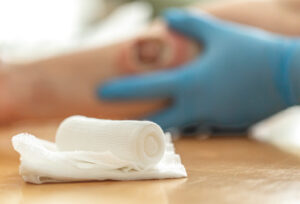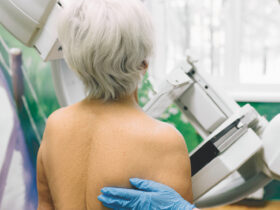By Dr. Neil Maldonado-Catinchi, Urgent and Primary Care Physician at Millennium Physician Group
 Pressure ulcers, commonly known as bedsores, are more than just uncomfortable wounds. They can lead to severe infections, hospitalizations, and even become life-threatening if not addressed early and properly. Unfortunately, pressure ulcers affect an estimated 2.5 million
Pressure ulcers, commonly known as bedsores, are more than just uncomfortable wounds. They can lead to severe infections, hospitalizations, and even become life-threatening if not addressed early and properly. Unfortunately, pressure ulcers affect an estimated 2.5 million
Americans each year, many of whom are older, immobile, or managing chronic health conditions.
As a primary care physician at Millennium Physician Group with a clinical interest in wound care, I see firsthand how early detection, prevention, and patient education can make a significant difference in avoiding these painful wounds.
What Are Pressure Ulcers?
Pressure ulcers are injuries to the skin and underlying tissue caused by prolonged pressure, often over bony areas such as the elbows, heels, hips, and tailbone. This constant pressure reduces blood flow, depriving tissues of oxygen and essential nutrients, which can lead to skin breakdown and cell death.
These ulcers can develop within hours of sustained pressure, especially when combined with moisture from sweat, urine, or stool, or with friction and shear (which occurs when the skin pulls in opposite directions, such as when sliding down in bed).
While many people associate bedsores with being bedridden, they can occur in anyone with limited mobility or impaired sensation, including people
who use wheelchairs, wear casts or splints, or are undergoing treatment requiring extended periods of immobility. Pressure ulcers can even develop under medical devices like oxygen tubing or inside the mouth from poorly fitting dentures.
The Stages of Pressure Ulcers
Pressure ulcers can develop quickly, and the severity of these wounds can vary depending on how deep the damage extends into the skin and underlying tissue. Healthcare providers use a staging system to classify pressure ulcers, which helps guide treatment and monitor healing progress:
• Stage 1: Skin appears red, pink, or discolored but is not open. It may feel warm, cool, softer, firmer, or tender to the touch.
• Stage 2: A shallow wound develops, appearing as an abrasion or blister.
• Stage 3: The wound extends into the fatty layer beneath the skin.
• Stage 4: The deepest stage, where muscle, tendons, or bones are exposed, carrying a high risk for severe infections like cellulitis, osteomyelitis, and sepsis.
Pressure ulcers can be painful and itchy, but people with reduced sensation may not notice them until they worsen. This is why early detection is crucial in preventing complications.
Bedsore Warning Signs
Understanding the warning signs of pressure ulcers can help you catch them early, before they progress to more severe stages. Symptoms to watch for include:
• Changes in skin color or texture, such as redness, discoloration, or shiny patches
• Swelling around bony areas
• Tenderness, pain, or areas that feel warmer or cooler than the surrounding skin
• Pus-like drainage or a foul odor from the wound
• Blisters or open sores
• Areas of hardened skin that feel spongy or firm to the touch
If you experience fever, chills, increased pain, or redness that spreads, these may be signs of an
infection that requires immediate medical attention.
Who is at Risk for Pressure Ulcers?
Anyone can develop pressure ulcers, but some individuals have a higher risk due to limited mobility, chronic conditions, or age-related factors. Knowing these risks can help you and your loved ones take proactive steps to protect your health.
You may be at higher risk for pressure ulcers if you have:
• Immobility from a chronic condition, stroke, spinal cord injury, or advanced age
• Incontinence, which increases moisture on the skin
• Poor nutrition and dehydration, leading to fragile skin
• Chronic conditions like diabetes, vascular disease, and heart or kidney failure
• Neurological conditions that impair the ability to sense discomfort
Older adults, especially those over 70 years of age, are particularly vulnerable due to thinner skin and reduced mobility.
Prevention is Key for Pressure Ulcers
The best way to manage pressure ulcers is to prevent them from forming in the first place. Your healthcare provider at Millennium Physician Group can help you create a personalized prevention plan that includes small, daily actions that can make a significant
difference in protecting your skin and overall
health – especially for individuals at higher risk. These steps can consist of changing positions regularly, inspecting the skin daily, maintaining a healthy diet, engaging in safe exercises, and quitting smoking.
Find Prevention and Care at Millennium Physician Group
As your partner in health, Millennium Physician Group is committed to providing proactive, patient-centered care. Whether you or your loved one is managing mobility challenges, living with chronic conditions, or recovering from an illness, our healthcare team will support you with a
personalized plan designed to enhance your health and overall well-being. Let’s work together to keep you on track for a healthier, more comfortable life.
Wishing you all healthy skin integrity, Neil Maldonado-Catinchi, M.D.
239-359-6514
MillenniumPhysician.com
400 8th Street N, Naples, FL 34102








